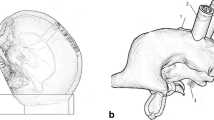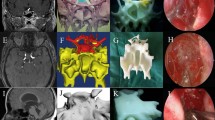Abstract
Purpose
We aimed to present a practical three-dimensional (3D) printed simulator to comprehensively and effectively accelerate the learning curve of endoscopic endonasal transsphenoidal surgery (EETS).
Methods
The 3D printed simulator consists of three parts: (1) skull frame, (2) the nasal passage and the nasal alar of the face, and (3) a modified sella turcica. We aimed to improve three basic operational skills of surgeons: drilling, curetting, and aspirating. Eighteen neurosurgeons and five post-graduates were recruited and consented for the training.
Results
For trainees, (1) as the training progressed, the scores increased gradually, (2) a significant increase in the average scores was observed in the tenth training compared to the first training, and (3) there is a significant decrease in trainee variability in the shortening of the gap. The 18 neurosurgeons were divided into three groups: experts, assistants, and observers. For all three basic operations, (1) the average score of experts was obviously higher than that of the assistants, observers, and trainees’ tenth training and (2) the average scores of assistants and observers were obviously higher than that of trainees’ first training. A significant high in the average score between the assistants and the observers was seen for aspirating, but not for drilling or curetting. For curetting and aspirating, the tenth training average score of trainees was obviously higher than that of assistants and observers.
Conclusion
This 3D printed simulator allows different endoscopic basic operations to be simulated and improves the EETS techniques of surgeons. We believed it to be a practical, simple, and low-cost simulator.







Similar content being viewed by others
References
Jho HD, Carrau RL (1997) Endoscopic endonasal transsphenoidal surgery: experience with 50 patients. J Neurosurg 87:44–51
Oertel J, Gaab MR, Tschan CA, Linsler S (2015) Mononostril endoscopic transsphenoidal approach to sellar and peri-sellar lesions: personal experience and literature review. Br J Neurosurg 29:532–537
Linsler S, Gaab MR, Oertel J (2013) Endoscopic endonasal transsphenoidal approach to sellar lesions: a detailed account of our mononostril technique. J Neurol Surg Part B-Skull Base 74:146–154
Chi F, Wang Y, Lin Y, Ge J, Qiu Y, Guo L (2013) A learning curve of endoscopic transsphenoidal surgery for pituitary adenoma. J Craniofac Surg 24:2064–2067
Rehder R, Abd-El-Barr M, Hooten K, Weinstock P, Madsen JR, Cohen AR (2015) The role of simulation in neurosurgery. Child’s Nerv Syst ChNS: Off J Int Soc Pediatric Neurosurg 32:43–54
Olabe J, Olabe J, Sancho V (2009) Human cadaver brain infusion model for neurosurgical training. Surg Neurol 72:700–702
Rosseau G, Bailes J, del Maestro R, Cabral A, Choudhury N, Comas O, Debergue P, De Luca G, Hovdebo J, Jiang D, Laroche D, Neubauer A, Pazos V, Thibault F, Diraddo R (2013) The development of a virtual simulator for training neurosurgeons to perform and perfect endoscopic endonasal transsphenoidal surgery. Neurosurgery 73(Suppl 1):85–93
Jaimovich SG, Bailez M, Asprea M, Jaimovich R (2015) Neurosurgical training with simulators: a novel neuroendoscopy model. Child’s Nerv Syst ChNS Off J Int Soc Pediatric Neurosurg 32:345–349
Tai BL, Wang AC, Joseph JR, Wang PI, Sullivan SE, McKean EL, Shih AJ, Rooney DM (2015) A physical simulator for endoscopic endonasal drilling techniques: technical note. J Neurosurg 124:1–6
Okuda T, Yamashita J, Fujita M, Yoshioka H, Tasaki T, Kato A (2014) The chicken egg and skull model of endoscopic endonasal transsphenoidal surgery improves trainee drilling skills. Acta Neurochir 156:1403–1407
Okuda T, Kataoka K, Kato A (2010) Training in endoscopic endonasal transsphenoidal surgery using a skull model and eggs. Acta Neurochir 152:1801–1804
El-Fiki ME, Aly A, Elwany S (2012) Binasal endoscopic approach to the sellar region: experience and outcome analysis of 80 cases. J Neurol Surg B Skull Base 73:287–291
Arora H, Uribe J, Ralph W, Zeltsan M, Cuellar H, Gallagher A, Fried MP (2005) Assessment of construct validity of the endoscopic sinus surgery simulator. Arch Otolaryngol Head Neck Surg 131:217–221
Nogueira JF, Stamm AC, Lyra M, Balieiro FO, Leao FS (2008) Building a real endoscopic sinus and skull-base surgery simulator. Otolaryngol Head Neck Surg Off J Am Acad Otolaryngol Head Neck Surg 139:727–728
Satava RM (2010) Emerging trends that herald the future of surgical simulation. Surg Clin North Am 90:623–633
Selden NR, Origitano TC, Hadjipanayis C, Byrne R (2013) Model-based simulation for early neurosurgical learners. Neurosurgery 73(Suppl 1):15–24
Hayashi N, Kurimoto M, Hamada H, Kurosaki K, Endo S, Cohen AR (2008) Preparation of a simple and efficient laboratory model for training in neuroendoscopic procedures. Child’s Nerv Syst ChNS Off J Int Soc Pediatric Neurosurg 24:749–751
Filho FV, Coelho G, Cavalheiro S, Lyra M, Zymberg ST (2011) Quality assessment of a new surgical simulator for neuroendoscopic training. Neurosurg Focus 30:E17
Lemole M, Banerjee PP, Luciano C, Charbel F, Oh M (2009) Virtual ventriculostomy with ‘shifted ventricle’: neurosurgery resident surgical skill assessment using a high-fidelity haptic/graphic virtual reality simulator. Neurol Res 31:430–431
Bodhinayake I, Ottenhausen M, Mooney MA, Kesavabhotla K, Christos P, Schwarz JT, Boockvar JA (2014) Results and risk factors for recurrence following endoscopic endonasal transsphenoidal surgery for pituitary adenoma. Clin Neurol Neurosurg 119:75–79
Zador Z, Gnanalingham K (2013) Endoscopic transnasal approach to the pituitary—operative technique and nuances. Br J Neurosurg 27:718–726
Acknowledgments
We thank the teaching and research section of anatomy, Nanjing University, for technical support and equipment assistance.
Author information
Authors and Affiliations
Corresponding author
Ethics declarations
Funding
The authors have no support or funding to report.
Conflict of interest
The authors declare that they have no conflict of interest.
Rights and permissions
About this article
Cite this article
Wen, G., Cong, Z., Liu, K. et al. A practical 3D printed simulator for endoscopic endonasal transsphenoidal surgery to improve basic operational skills. Childs Nerv Syst 32, 1109–1116 (2016). https://doi.org/10.1007/s00381-016-3051-0
Received:
Accepted:
Published:
Issue Date:
DOI: https://doi.org/10.1007/s00381-016-3051-0




